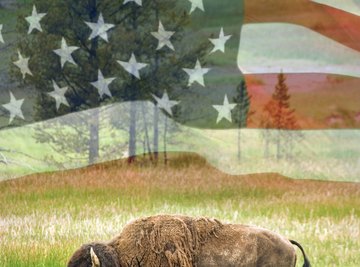
The American bison is a large member of the cattle family that once dwelt in prairies, plains, woods and river valleys across Canada, the United States and parts of Mexico. In the past, herds of bison that historians believe numbered in the millions once swept across the plains as they migrated in of food. As of 2011, they are confined to a handful of parks and wildlife refuges in the United States and Canada.
General Characteristics
Sometimes called a buffalo, the American bison is North America's largest land animal. They have large, low-slung heads, shaggy manes, beards, short horns and large humps. A male bison can weigh more than 2,500 pounds, stand about 5 feet tall at the shoulders and reach a length of about nine feet. Females are slightly smaller. Biologists divide American bison into two species. The wood bison is taller and less stocky than the plains bison.
Migration
Bison are grazing animals that feed on grasses, sedges, lichen and berries. In the past, plains bison would migrate for hundreds of miles as they searched for food in the winter. In the Great Plains regions bison herds would follow the same route every year, wearing paths in the soil. Some of these paths are visible from the air. Wood bison, on the other hand, maintain much smaller ranges, alternating between meadows and the surrounding forest.
Habitat
As of 2011, bison are only found in national parks and wildlife refuges in the United States and Canada. They can be seen in National Bison Refuge in Montana, Wichita Mountains National Wildlife Refuge in Oklahoma, Fort Niobrara National Wildlife Refuge in Nebraska, Yellowstone National Park in Wyoming, Sullys Hill National Wildlife Refuge in North Dakota, Walnut Creek Wildlife Refuge in Iowa and the Wood Buffalo National Park in Northwest Territory, Canada.
Hunting
The Plains Indian tribes, such as the Sioux, would hunt migrating bison for meat, hides and bones. They used the bison as a source of food and raw materials for tools, clothing and shelter. Historians estimate that 60 million bison lived in North America at the beginning of the 19th century. As European settlers began moving West, they hunted the bison for sport, frequently shooting at the herds from the train. By 1890, settlers had killed all but 1,000 bison for their hides and tongues. In 1905, the American Bison Society began working on protecting them from extinction. In 2004, there were about 500,000 bison.
References
- "The Columbia Encyclopedia"; Bison; 2008
- Ultimate Ungulate: American Bison
- "Warrior"; R.G. Grant; 2007
About the Author
Frank B. Chavez III has been a professional writer since 2006. His articles have appeared on numerous websites including WitchVox and Spectrum Nexus as well as in the e-magazine Gods and Empires. He has his associate degree with an emphasis in theater arts from Chabot College, where he received the theater department's Joeray Madrid Award for Excellence in Dramaturgy.
Photo Credits
Thinkstock/Comstock/Getty Images
